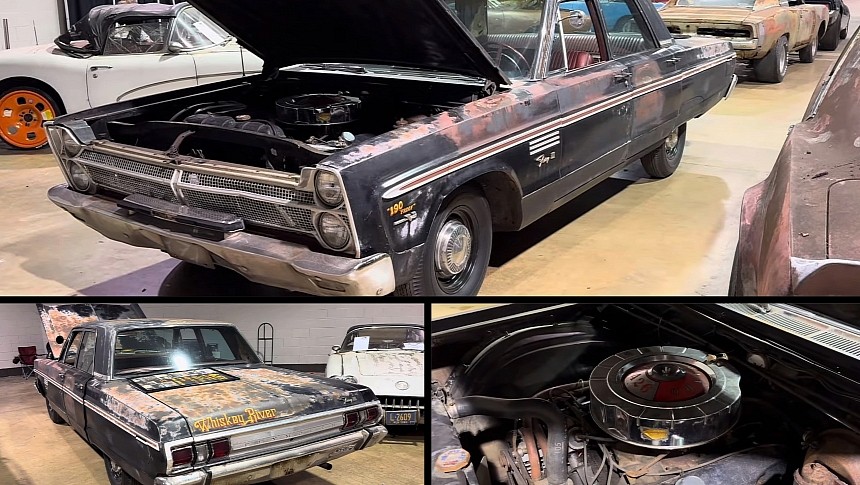Initially introduced as a fancied-up, higher-performance version of the Belvedere in 1956, the Plymouth Fury became a stand-alone nameplate in 1959. It was offered in various body styles, and the engine lineup included everything from fuel-efficient inline-six mills to big-block V8 powerplants.
Originally a full-size model, the Fury became an intermediate in 1962. That changed in 1965 when Plymouth moved the nameplate back into the full-size car market as a counterpart for the third-generation Dodge Polara.
And like all Chryslers based on the C-body platform, the Fury got the 440-cubic-inch (7.2-liter) RB V8, but it was never fitted with the iconic 426-cubic-inch (7.0-liter) HEMI. However, a few fourth-generation cars were equipped with the 426 Street Wedge.
Discontinued around the same time the street-legal HEMI became available, the Street Wedge was related to the more iconic and race-oriented Max Wedge. It wasn't as potent as the latter, but its 385-horsepower rating turned the full-size into a proper muscle car. It's also a fairly rare classic.
If you have yet to see an early fourth-gen Fury Street Wedge, one recently popped up at the 2023 Muscle Car and Corvette Nationals (MCACN). And it's quite the special rig. Because while the Street Wedge V8 is usually associated with two-door Mopars, this 1965 Fury III is a four-door sedan.
That's right, whoever ordered this rig back in the wanted a fully-fledged sleeper. The owner also specified a four-speed manual for three-pedal fun but went with a front bench seat. The color combo is also a bit unusual, as the black exterior was paired with burgundy upholstery.
But that's not all. According to the sheet beside the car, this Fury III spent its early days hauling moonshine. Apparently, the owner knew exactly what he was going to do with his then-new Mopar.
And to answer the question on everyone's lips: yes, bootleggers were still operating in the 1960s. Although the Prohibition was repealed in 1933, moonshine remained a thing until the late 1960s, and a number of drivers continued to run illegal booze to evade tax men.
Finally, this Fury III was part of MCACN's Barn Find display, so it's an unrestored gem. I wouldn't call it unmolested, given its early career as a 'shine runner, but it appears to be highly original. The Street Wedge mill should also be a numbers-matching unit based on its appearance.
Unfortunately, Plymouth did not keep detailed records on how many Street Wedge Fury sedans it sold in 1965, but it's a pretty rare classic. I do know that the company sold four convertibles that year, so we're probably looking at one of fewer than 50 four-doors built and one of fewer than a dozen survivors. What a cool car!
And like all Chryslers based on the C-body platform, the Fury got the 440-cubic-inch (7.2-liter) RB V8, but it was never fitted with the iconic 426-cubic-inch (7.0-liter) HEMI. However, a few fourth-generation cars were equipped with the 426 Street Wedge.
Discontinued around the same time the street-legal HEMI became available, the Street Wedge was related to the more iconic and race-oriented Max Wedge. It wasn't as potent as the latter, but its 385-horsepower rating turned the full-size into a proper muscle car. It's also a fairly rare classic.
If you have yet to see an early fourth-gen Fury Street Wedge, one recently popped up at the 2023 Muscle Car and Corvette Nationals (MCACN). And it's quite the special rig. Because while the Street Wedge V8 is usually associated with two-door Mopars, this 1965 Fury III is a four-door sedan.
That's right, whoever ordered this rig back in the wanted a fully-fledged sleeper. The owner also specified a four-speed manual for three-pedal fun but went with a front bench seat. The color combo is also a bit unusual, as the black exterior was paired with burgundy upholstery.
But that's not all. According to the sheet beside the car, this Fury III spent its early days hauling moonshine. Apparently, the owner knew exactly what he was going to do with his then-new Mopar.
And to answer the question on everyone's lips: yes, bootleggers were still operating in the 1960s. Although the Prohibition was repealed in 1933, moonshine remained a thing until the late 1960s, and a number of drivers continued to run illegal booze to evade tax men.
Finally, this Fury III was part of MCACN's Barn Find display, so it's an unrestored gem. I wouldn't call it unmolested, given its early career as a 'shine runner, but it appears to be highly original. The Street Wedge mill should also be a numbers-matching unit based on its appearance.
Unfortunately, Plymouth did not keep detailed records on how many Street Wedge Fury sedans it sold in 1965, but it's a pretty rare classic. I do know that the company sold four convertibles that year, so we're probably looking at one of fewer than 50 four-doors built and one of fewer than a dozen survivors. What a cool car!











